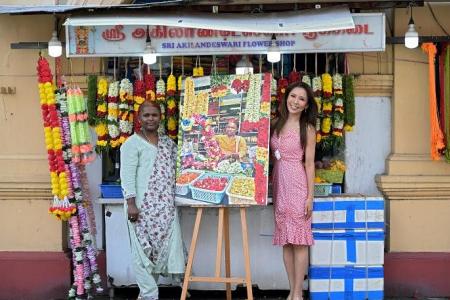Japanese artist celebrates Singapore’s heritage artisans with paint brush
An unlikely friendship has formed between a Japanese artist and a group of heritage artisans here.
Ms Tsuyumi Miwa, a Nagoya-born painter, started her Singapore Cultural Series in late 2021 to showcase unique skills here that are at risk of disappearing.
One of her muses is mala (garland) seller Sevugan Ponnalagu, who owns Sri Akilandeswari Mini-marts in Serangoon Road.
“She was my fourth subject and before her, it was all men,” said Ms Miwa, a Singapore permanent resident married to a Briton here. “I wanted to find a female muse but walking around Little India, I saw that 95 per cent were men.”
She found out from a tour guide about a female mala flower seller in Little India, and managed to hunt down Ms Ponnalagu after three attempts. After taking photographs of Ms Ponnalagu, she did an acrylic painting of her, which took over two months.
“I’m happy that she has done a good job,” said Ms Ponnalagu, 43, looking at the 100cm by 70cm painting of herself. “People always come and take my pictures or ask about my garlands. I’m like an Indian culture ambassador.”
She takes 10 minutes to make a simple garland, a craft she learnt by observing others over a decade ago. The garlands are used for prayers and weddings, and as hair adornments.
“There are fewer people doing this now,” said Ms Ponnalagu. “My three children will come to help out, but won’t take over this stall.”
Mr Tan Ah Hock, owner of Sin Hoe Hin Joss Paper Dealer in Chin Swee Road, is another artisan Ms Miwa featured. The 70-year-old learnt to make paper replicas of items at the age of nine from his grandfather and father. He hopes to pass on his business to his engineer son Vincent, 35.
“I wanted to put on a shirt for the painting, but Ms Miwa said I should appear as my normal self,” said Mr Tan, who toils topless over his papercrafts of items such as houses, cars and figurines.
These items are burnt during funerals and Chinese ancestral worship ceremonies.
“This is a dying art, with only about 20 artisans left,” said Mr Tan. “Some people import joss paper products from overseas now, but the workmanship may not be as good.”
Ms Miwa, who speaks English and Mandarin, has also painted a traditional kopitiam owner, a Taoist deity statue maker, a cheongsam tailor and a Peranakan shoemaker.
Her upcoming subjects include a Chinese cultural antique and vintage instrument seller, a string puppet performer and a maker of fire dragons, which are made of straw and burnt in temple rituals.
She hopes to uncover more unique skills and traditions that make up the rich tapestry of Singapore’s cultural identity.
Ms Miwa, who declined to give her age, started painting at the age of three and enrolled in Tama Art University in Tokyo to study theatre and art. After working as a radio and television announcer in Tokyo, she came to Singapore in 2012 and rediscovered her love of painting.
She has done commissioned works, such as portraits of people, and paintings of animals and nature. She currently has an exhibition at the Singapore Polo Club featuring horses and nature.
Ms Miwa plans to have her Singapore Cultural Series culminate with an exhibition and a guided tour to watch her artisan subjects at work.
“People should be able to smell the flowers and coffee, and feel the energy and vibes, which cannot be done through paintings,” she said. “I want to inspire their five senses through the tours.”
She gets help from friends such as heritage enthusiast Victor Yue to find her artisans.
“I help anyone who is interested in our heritage, and she has the skills to help these craftsmen leave a legacy behind through her paintings,” said Mr Yue. “We should be like Japan, where the heritage artisans are treated like national treasures.”
Ms Miwa is grateful for the help she has received from Singaporeans, including the craftsmen. “They are all so welcoming,” she said. “I am so privileged to see their work up close, and have them share their stories with me.”
The artisans wondered why she was interested in them. “They said they are very ordinary, but I told them they are extraordinary people who have been dedicated to their crafts for so long,” she said.
As an artist, Ms Miwa shares a special connection with the artisans. “Sometimes, people only notice the tradition when it’s gone,” she said. “I love Singapore very much, and I hope to contribute by capturing Singaporean culture.”
Mr Alvin Tan, deputy chief executive of policy and community at the National Heritage Board, told The Straits Times that in this digital age, Ms Miwa’s efforts to get to know Singapore’s intangible cultural heritage practitioners and document their crafts through the medium of art are commendable.
“With her paintings, Ms Tsuyumi Miwa joins the ranks of artists who have captured and celebrated different aspects of Singapore’s heritage, and we hope that her efforts will inspire others to join us in safeguarding and promoting our heritage for present and future generations.”
Get The New Paper on your phone with the free TNP app. Download from the Apple App Store or Google Play Store now


